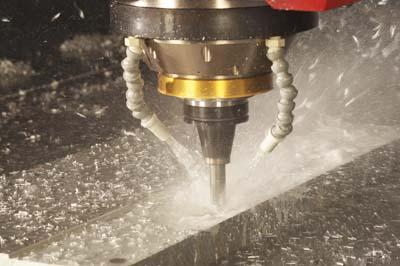
CIMCOOL Fluid Technology's HFP LINE OF FLUIDS WITH FACT (foam arrest control technology) produce less foam, which results in better lubricity than leading metalworking fluids, making these products an ideal choice for applications that include high speed machining and metalworking operations. This cost effective line of fluids offers superior rancidity control and is compatible with most conventional waste treatment methods. The HFP fluids serve a wide range of applications including:
CIMPERIAL 1060CF-HFP WITH FACT, A chlorine-free, premium soluble oil offering excellent finish and part quality in the machining and grinding of ferrous and non-ferrous materials. CIMPERIAL 16 EP-HFP WITH FACT, Ideal for high turnover, high-pressure applications where minimization of foam is critical for part quality and machine operations.
CIMSTAR 60C-HFP WITH FACT, A premium semi-synthetic that contains a chlorinated EP lubricant for heavy-duty operations providing the performance capabilities of soluble oils.
CIMSTAR 70C-HFP WITH FACT, Blends the technological advantages of synthetic lubricants with the performance of soluble oils for machining and grinding in moderate to heavy-duty operations.
CIMTECH 320-HFP WITH FACT, A unique, low-pH synthetic fluid designed for the aerospace industry. Excellent for moderate to heavy-duty operations on aluminum and is very low foaming, even when used with deionized water.
CIMTECH 510Z-HFP WITH FACT, Offers all the advantages of a synthetic fluid, with the performance capabilities of a heavy-duty product. Ideal for central system applications and is recommended for moderate to heavy-duty machining and grinding operations of ferrous materials where a synthetic is desired.
Contact Details
Related Glossary Terms
- extreme pressure additives ( EP)
extreme pressure additives ( EP)
Cutting-fluid additives (chlorine, sulfur or phosphorus compounds) that chemically react with the workpiece material to minimize chipwelding. Good for high-speed machining. See cutting fluid.
- grinding
grinding
Machining operation in which material is removed from the workpiece by a powered abrasive wheel, stone, belt, paste, sheet, compound, slurry, etc. Takes various forms: surface grinding (creates flat and/or squared surfaces); cylindrical grinding (for external cylindrical and tapered shapes, fillets, undercuts, etc.); centerless grinding; chamfering; thread and form grinding; tool and cutter grinding; offhand grinding; lapping and polishing (grinding with extremely fine grits to create ultrasmooth surfaces); honing; and disc grinding.
- lubricity
lubricity
Measure of the relative efficiency with which a cutting fluid or lubricant reduces friction between surfaces.
- metalworking
metalworking
Any manufacturing process in which metal is processed or machined such that the workpiece is given a new shape. Broadly defined, the term includes processes such as design and layout, heat-treating, material handling and inspection.
- rancidity
rancidity
Bacterial and fungal growths in water-miscible fluids that cause unpleasant odors, stained workpieces and diminished fluid life.

